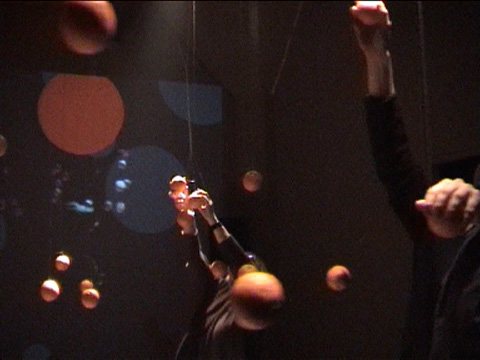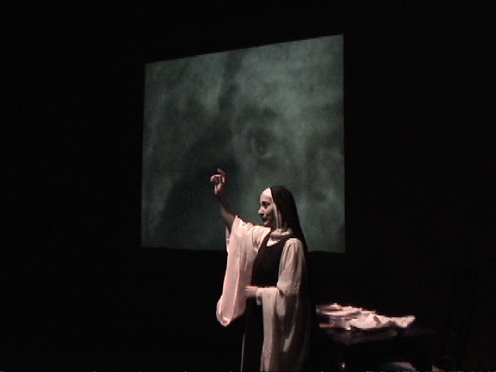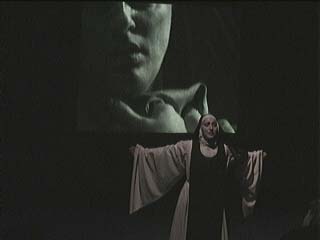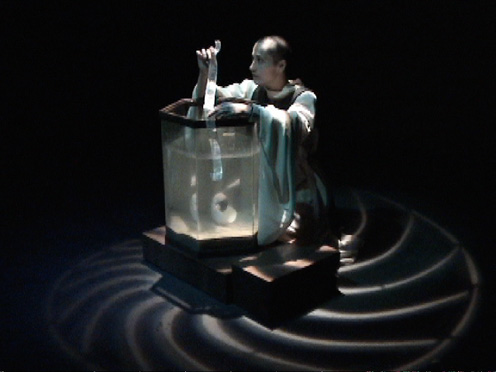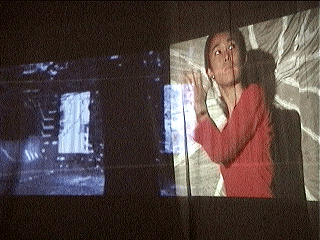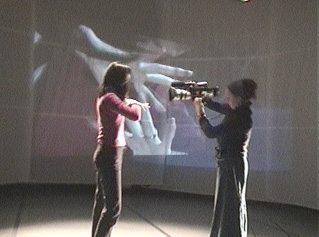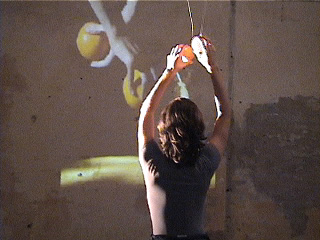Design And Performance Lab
|
Interacting
Johannes Birringer (c) 2003
"East by West," interactive telematic installation, by Johannes Birringer, Sher Doruff, Orm Finnendahl, DEAF 2003.
The conditions under which we work have changed.
The theatre I want to talk about here is a theatre which addresses a
complex global world of many intersecting cultures, languages, media
of communications, and immaterial information. The theatrical system
of representation has always included material forms (texts, architectures,
objects) and immaterial information (personal memories, collective stories,
songs, dance, rituals, performance-behaviors, celebrations, games).
The theatre of the material archive, with its national canons of plays
and technical pedagogies, with its maps for the production of closed,
completed and autonomous stage works, is now similar to the museum of
the old masters. The contemporary theatre is a hybrid theatre of transmediality
which moves between forms drawing from diverse popular cultures and
the digital media which drive them and distribute them globally. In
this theatre, the old roles of the script, the director, and the actor
gradually disappear. It will be necessary, first, to outline some of the conceptual aspects of live art/performance and interactivity in order to place my theory of "inter-acting" into the contemporary context of new media practices. For a critical understanding of the contemporary relations between theatre and technology, it is important to define the parameters for the aesthetic and social construction of multimedia work that is promoted as "interactive" or "online performance," especially at a time when art academies are beginning to introduce courses in "digital theatre" based on design concepts generally derived from gaming, 3D animation and VR (virtual reality) design. The shift towards design and the programming of malleable environments, as we also see it in artificial life research, the biological sciences, and the computer-generated models of contemporary architects (FOA, Diller + Scofidio, Frank Gehry, Peter Eisenman, Greg Lynn, etc), is a clear sign of the impact of computing on all areas of cultural and scientific production. Interactive art and networked performance, two areas of computer-mediated production that are most relevant to our expanded notion of the theatre, often overlap but are not equivalent. In fact, the conceptual differences - in the use and understanding of interactivity - between performers and digital media artists can be significant. The transcultural development of interactive genres in the current context of globalization, and the integration of interactive tools into theatre and dance practices, suggests that we look at the historical conditions for the current use of interactive design processes. A focus on design implicates political questions regarding the contingencies of the performing body in its coupling with technological systems. It allows us to formulate a politics of interaction which offers alternatives to representational theatre and to the dominance of the image in contemporary media performance. In particular, such alternatives concern the role of kinetics and "behavioral play" in transmission. Playing through movement, or movement interfacing with distributed spaces of the internet, implies new phenomena of proprioception and feedback in displaced actions. 9 Interaction: Beyond Spectacle The notion of "interactivity" - connecting bodies to digital interfaces - gains its meaning if we read it in the context of design processes which build an extended, transindividual nervous system. The discourse on the body in live art and the politicized representational theatre relied on familiar political notions of subjectivity, identity, knowledge, power, nature, etc., filtered through the lessons learnt from Foucault and recent feminist and performance theory. Transmediality, however, points away from the individual body to techniques of the machine and complex human-technical involvement, to a communication loop that involves technology. As a mode of technical mediation within a collective infrastructure, interactivity points to a new understanding of environments of relations and a relational aesthetics based on interhuman exchange or physical interaction as well as a new technological kinesthetics. Designing digital interfaces in dance, for example, means organizing a sensory and intelligent space for communicative acts that are inherently changeable and unpredictable. The space is not "set" for a fixed choreography, but programmed for potential interactions and movements in which partners behave within a network of relays and responses, and in which technologies and media generate perceptions of reality. Interaction thus involves the whole environment, and it maps its "world" through the continuous biofeedback it receives via direct sensory stimuli which are also technically mediated (sound, image projection, tactile sensors, wearable computing built into textiles, etc). (1) In terms of compositional operation and outcome, interactive art is grounded in an aesthetics of process, an art historical notion referring to the dematerialization of the art object in the conceptual and ephemeral, performance-based practices of the 1960s. Beyond these live art connotations, process as interactive playing can be associated with a wide spectrum of behaviors in social, pedagogical, therapeutic, gaming and sports contexts and, for example, in the activities of online game players participating in gaming worlds where numerous people playing roles make up the plot in the process, trading and chatting, joining or building separate clans, adding to the environment or altering it, while the software of the game engine provides the parameters or proposes rules of play. The modernist notion of composition no longer applies; rather, the programming of an environment resembles a kind of continuous postproduction of recording/recorded data, as interactivity uses the input from the tools of connection and manipulates, mixes, and remixes the samples, which in the case of dance includes bodily movements, gestures, sensations. The same open-space concept of interactivity in dance is now also explored in the gaming world, with EyeToy and Playstation programs where there is a dynamic environment for physical audience interaction. The emphasis has shifted from the object of representation to the emergent situation or playground, and the materialization of technology, itself. Interactive real time computing in installations shifts the "process" to the physical involvement of the observer or user, and thus alters all conventional distinctions between "artwork" and "observer," which is not the case in interactive performances staged for an audience. Interactivity, in general, offers and assigns roles to the users when interacting becomes an essential component in the condition of the situation, its actualization and reception. As a consequence, interactivity undermines the aesthetics of spectacle. I define interactivity as collaborative performance with a control system in which the performer- action or play is tracked by cameras, sensors or other interface devices and thus used as input to activate or control other component properties from media such a video, audio, motion capture and midi-data, text, graphics, scanned images, etc. The latter scenario I call an interactive performance system that allows performers and computers to generate, synthesize and process images, sound and text within a shared real-time environment. The real-time processing differs from the historically evolved understanding of multimedia performance, either based on a dramaturgy/choreography or more open-ended constellations like the chance operations Merce Cunningham has used in his dance collaborations (most recently with Paul Kaiser and the Riverbed Design Studio). Historically, interactivity as an aesthetic category does not derive from a political context, for example the actionism of live art that incites public intervention, ranging from guerilla theatre to various anarchist or protest movements. Happenings and participatory rituals, like underground rock and punk music, belong to a romantic discourse of opposition, whereas interactivity basically denotes an economy and ecology of exchanges, it concerns technical processes and the question of boundaries or interfaces between living bodies and technological networks. Interface design is a fundamentally commercial activity (cf. computer games), and of course it also trains us to live in a culture of technical apprehension. Oliver Grau, for example, in his study of virtual
reality traces the concept of immersion through a long history of image
spaces (panoramas) of illusion, and argues that virtual techniques attempting
to overwhelm the senses and fuse the observer with the image medium
are not new, but that today's real-time computation and sensorial interactivity,
linked with telepresence and distributed networks, infinitely expand
the "processual Compared to interactive installations and virtual reality environments, interactive performance in the strict sense of computer-assisted design cannot claim such a long history, nor has it resolved its relationship to the spectator as user. The proscenium is the dilemma, as long as theatre practitioners remain committed to presentational stagings of multimedia works for the consumption and aesthetic contemplation of the audience. Another unresolved question might be how audiences will behave once intervention into the performance is expected and becomes conventional. At this point, we can observe how interactivity is explored on stage, and how it is explored without a stage. In the following, I trace the connections between these models.
As I suggested, we now work in interactive environments, with dynamic collaborative processes that bring actors, dancers, and musicians together with programmers, filmmakers, composers, and engineers. The politics of the process have changed, requiring new concepts of "script" and "dramaturgy." When we develop a new piece, we worry about the interface design since it decides how meaning and affect become manifest. The process is a new intimate interaction with digital materials. We adopt to the mediated environment, and affect the evolution of image and sound design. Joining in different flows at the same time creates the possibility of networking streams of material and immaterial data, so as to create an awareness of where we are and what we can do. We do not live in societies that use digital archives, we live in a global information world which is a digital archive. Understanding the world means understanding what digital databases can or cannot do. But we have to expand memory in order to recognize images of ourselves. There are so many images, and the speed of the digital technologies is so fast that we need to slow down. The performing body in this theatre of transmediality will be a slow body. Not an "obsolete body," as Stelarc as predicted, no doubt tongue-in-cheek, but an expressive body that incorporates the sensorial environment and acts with it or is "acted": a body of information, improvising with new cognitive and kinesthetic processes, and a new awareness of networks and connected realities (internet, telepresence).(3) The network is a living collective data base environment, always fluid and evolving, elastic, changing, and unpredictable. The theatre adopts the network as a metaphor and a practice. The networked theatre creates new roles (for the actor and the audience as inter-actors) and new processes of exchange. It begins to demonstrate the dimensionless reality of a "digital" discipline. A discipline that is perpetually in the process of a loss of ground, a loss of discipline - a forgetting and isolating effect that perhaps forms digital transmediality, an involution of ideas, realities, spaces that are already present somewhere else. The spaces, realities, aesthetics and effects of digital production and cultural translations have a spectrum of simultaneous potentials and presences that continue to move-between, dispelling any fixture or location. This allows for cultural production -- production that is necessarily within a digital cultural environment -- to be continuously reconfigured, resposited, and recognized: fluid samplings and exuberant aesthetics that are perpetually represented in and by different locations. Renato Cohen, a theatre artist from São Paulo, has called these practices "human technologies," including phenomenological experiences of shamanism, traveling of spirits, possession, doubling, and convergences of the Eastern and Western cultures.(4) This process is seen already in film, design, music, online cultures and many other fields of interactive production. We see a huge blurring of the lines of authorship. For example, in music culture, the relations between performance and production roles (songwriter, musician, producer, sound engineer) have changed. In the current DJ culture, scratching and mixing are performance styles that also display the vast archive of prerecorded music. The practice of "live mixing" incorporates the archive into performance material in real-time. The "archive" is re-usable as information that can be animated, moved, distorted and recomposited, multiplied and sampled. In this sense of dislocation, it is also a paradox to speak of the transmedial theatre as having a "Western" or "Latin-American" identity, even if we argue that the Wooster Group is based in New York City and El Periférico de objetos in Buenos Aires. Rather than reflecting a cultural location, the transmedial theatre mixes various forms of cultural communication to reflect on the limits of the theatrical system itself. Renato Cohen has suggested that we are all working in an international network; local culture is subliminal, archival forms running in the unconscious of the actor. In my first example, the archival material is opened up for recompositing. 3. Sueño: The Actress as Filmmaker I offer three scenes from this process of recompositing, drawn from an interactive play written and performed by Angeles Romero. Its performance was first designed (in early 2003) for Ohio State University' s Mount Hall, a black-box theatre. Sueño refocuses the life of 17th Century Mexican nun, Sor Juana Inés de la Cruz. Sor Juana is an iconic figure in Latin America and Spain, her fame based on her voracious drive for knowledge and her exceptional gift as a writer. From her silent solitary cell, this free-thinking nun conducted scientific experiments, wrote hundreds of poems, plays as well as theological essays. She was frequently attacked and chose to defend not only her own interest in worldy learning, but also the broad rights of women to education and a life of the mind. With interactive digital video and sound sculptures, this performance evokes realities in the intellectual mindspace of "Sor Juana," a world that borders on a continuous sliding between concrete experiences, intellectual exercises and psychological hallucinations. In Scene Two, in which the actress creates an imaginary dialogue with Father Antonio, a film of Father Antonio appears. It is a projection of his head. She then intervenes into the image-movement, freezing the image with a snap. The still allows her a close-up observation of the physiognomy of the Father. Like under a microscope, distortions of the face become apparent, which elicit Sor Juana's interpretation of different perceptions of reality. The image itself then deteriorates, as she unfreezes it, and the film forwards slowly. The interaction highlights the function of the zoom/close-up as well the anamorphosis that is made possible through the digital compositing technology.
In Scene Six, which is an intimate seduction scene between the vicereina and Sor Juana, the projected film of Maria Luisa directly interacts with the stage actress. Maria Luisa demands that the actress look at her while she slowly undresses. The actress steps out of the scene and in complete darkness provides the voice-over to the black and white film. She implicates the audience in a narrative description (transported with the microphone) of psychological violence in her fantasy: a paradoxical erotic attraction and repulsion. Her verbal recitation, at the same time, echoes and repeats an earlier filmic image from Scene One which depicts an act of physical violence fantasized by the young Juana. The scene ends with the actress re-entering the scene to abort the seduction. In a precisely choreographed interaction between film and theatre, film actress and stage actress resolve the conflict by making an exchange: Maria Luisa asks for her manuscripts and Sor Juana places them at her feet.
In the final scene, Sor Juana becomes the filmmaker. Under a step the actress finds the hidden filmstrip of her life. She holds it against the light and like a filmmaker begins to develop the sequence of time-frames in her existence. The last frame situates her in panorama zero, a non-local, a-temporal continuum. The Sor Juana the audience met in the flesh becomes a memory in the moment her contemporary edition (a younger film actress) is gigantically projected against the wall. The modern film actress and the stage actress recite a poetic text that Sor Juana had written. The double recitation creates a spatial montage: as Eisenstein suggested many years ago, the spectator now travels with the image of the future that is created in the montage, seeing not the representative elements of a finished work, but experiencing the dynamic process of emergence. The actress of the future takes over while the stage actress already fades into memory of the past. Sueño mediates the actress's ability to exceed physical, spatial and temporal limitations. The crossing of filmic, theatrical and sonic spaces in the mixed reality of the performance reflects on the integration of "virtual" techniques. Interactive media change our idea of the theatrical image and allow a more complex, layered, polysensory experience of physical and abstract spaces.
4. Flying Birdman: Telepresence Telepresence integrates video, communication and network technologies into performance environments which connect distant sites via the internet. The production process involves international collaboration and project management of remote and multiple site events with streaming media, web technologies, video production and editing, and the live coordination of mediated performance across different time zones. It is also called "telematics," defined by Roy Ascott as "computer-mediated communications networking between geographically dispersed individuals and institutions… and between the human mind and artificial systems of intelligence and perception."(5) Telepresence leaves the stage as well as the local area network (LAN) behind; it operates in a world-wide transmission system that is accessible by anyone with a computer and a modem. Interaction between remote performance partners involves a variety of protocols and strategies; most of them are familiar to internet users who have used chatrooms and browsers, downloaded streaming media or explored the hypertextual linking of networked computing systems.
Flying Birdman was created collaboratively online (November 2002), produced by seven teams that are part of the research group ADaPT (studios in Phoenix, Los Angeles, Detroit, Columbus, Salt Lake City, Madison, Nottingham, Brasilia and São Paulo).(6) This performance linked five cities in the United States with two locations in Brazil. It was based on short narratives and structured spirally like a Japanese "renga" (poem), composed of live dance, real-time audio and sound processing, precorded filmic images, still images, spoken voice, and graphic text-communication exchanged by participants and audience during the live performance. The performances in the various sites played with the theme of "left-overs," debris, decomposition, and the idea of re-cycling. The anchoring voice of the Flying Birdman ran through the entire telematic performance, but this voice of the fictive Birdman was also under-scored with subtle audio mixes and other traveling and whispering voices that functioned like echoes or reverberations of single words. These words were randomly chosen by the participating performers, picked up and digitally transformed by the other collaborating site partners. The run-on voice of the Birdman was recited by five sites while the other streams were created (video, movement, still images, drawing, writing). The Birdman's voice changed and transformed from one language to an other. Each site functioned both like a film set and a gallery for the local public that was invited. The website address for the online performances was announced on the internet. Each site was free to design their environment for the production and transmission; we agreed that each local site would experiment with panoramic or surround screens (with many windows open at the same time) allowing for the performers/participants to see all sites dialogue with each other in a spiral. This cinematic arrangement also allowed local live audiences to see the intersection of public and virtual spaces, and how the local actors constructed the dialogues with remote partners in real-time. My role was to create a digital dramaturgy for this telematic "earthwork," as I began to call it in reference to Robert Smithson's Spiral Jetty. I envisioned a spiraling dialogue - between sites and "non-sites" - with at least two sites dialoguing with each other (video, audio) at any given time during the 10 scenes. Each scene was six minutes long. The dialogue was passed on and moved around, and the internet audience could follow the movement of the dialogue by opening the respective site-addresses (URLs).
Although the internet is a new medium, we are re-adapting existing forms and media to the new interface. We see telepresence as an interactive environment that allows the real-time synthesis of various media forms in a distributed performance. These media respond to each other over large distances. We are separate but appear to be together in a shared virtual space. The emphasis is still, to some extent, on the performer actions, not on journeys in pure data environments or synthetic worlds (games). The radical challenge is that we perform these interfaces without that all partners (and audiences) are physically present and in one location. We don't know our internet audience; we are no longer on a "stage." This also leads to a re-scaling or modifying of existing aesthetic operations. The professional experience of most of the ADaPT members is dance/physical performance. In telepresence, performance is adapted into live camera-editing/framing and thus a form of live filmmaking and live soundmixing, accompanied by textual communication (chat) which functions as a secondary or commentating medium (like subtitles), not necessarily yet as a new hypertextual poetics. We have not fully explored other forms of online performance which involve interactive storytelling or distributed web narratives as platforms for the audience's direct collaboration in fiction development or in spatialized narrative wherein the interactive user takes the role of cameraperson and editor.(7) Initially, our collaborative ADaPT work experimented with connectivities, infrastructures, and languages we could use. We had to decide on a shared software and agreed-upon protocols. We improvised together, following the model of free jazz or hip hop jams. With "Flying Birdman" I proposed a precise dramaturgy built on cybernetic principles of the feedback loop. "Roles" were passed on, from site to site, the behavior of the digital objects was unpredictable and thus affected the behavior of the system they constituted. The loop narrative was translated into streaming video and audio, and different components of the story were developed by the participating sites. In this sense the narrative became a Roshamon-like spiral, distributed among the participants. Each site would see something different, for sure. The dramaturgy only referred to the length of each scene and the distribution of roles/media, not to the content which would evolve. One of the main challenges in telepresence dance is the conscious incorporation of the camera interface into the performance, with dancer and cameraperson working very closely together in a restricted area that has to be well lit. Camera and microphones (connected to the computer) are the key interface between performer and network technology. They are the basis for linking the different site-environments into meaningful relationships between the visual and kinesthetic forms and digital outputs. Taken together, the seven sites produce a form of real-time digital compositing, since some of the partner sites also use video mixers and compositing software. Dance here becomes a filmic practice, since much of the attention goes to the phrasing and framing of the action, the choice of camera angles, camera movement, and in-camera editing or mixing, the "montage within a shot" (Lev Manovich). The sound does not have to flow directly into the webcast but can be filtered and modified through interactive software. A second challenge is the strategic use of the small delays in internet transmission (how small depends on the network traffic at any given time) and the degradation of image and audio transfers. Depending on the choice of thematic content, the break-ups and fragmentations of the video stream can become part of the aesthetic.
The strongest moments happened when the dancer (Birdman character) was moving with or - seemingly - through the landscape or architectural filmspaces of another site, becoming "present" in a virtual space. The telepresent actor is present in a distant image world which is being created by others. The camera work (framing, angle, motion) transports the actor into the frame compositions of the virtual image. Digital real-time dramaturgy implies that the actor or dancer is integrated into, or inserts herself into, a moving architecture, allowing the viewer to make particular associations, if you imagine such a figure to be on the edge or "inside" a dream space or moving through a "navigable space." Telepresence, or tele-action, means entering into the streaming images of the remote site, thus affecting the reality or virtuality perceived at that location. Even more crucial, for our purpose, is the recognition that live performance, unlike completely synthetically computer-generated environments or game worlds, brings corporeality as real material into the teletechnologies and, via the streams, to a real remote physical location. Information streams have more resonance when they appear in a "concrete scene." When their proportions are measured by our bodies, they become part of our physical existence and then close the gap between tangible and abstract architectures. When we dance in telepresence, we cannot become completely immersed in the illusion that our bodies are elsewhere, since we remain aware of our being in a separate physical environment. We see our projected arms, shoulders and faces appear in another environment, and since the telematic image has a delay of a few seconds, our telepresenced bodies will always try to catch up with us. We dance in a strange feedback-loop. And then there are the little mistakes that happen, in the network transmission. Our bodies freeze, break up, then recompose, or our partners on the other side have changed our colors, inverted us, or multiplied us into a polyp with many arms. As we gain facility with the interface, we can play with the distanced body images and have ironic relationships with the processing of our (image) movements, enjoy the thrill of the exchange of energies and strange imaginings with performers in the other sites, and savor the natural precariousness of temporary networks with their lags, interruptions and collapses. These network environments, after all, behave like an unstable ecological system, and everything evolves through adaptation. Telepresence challenges interaction. We must
find the particular qualities of the interaction experience, and negotiate
cultural and technical differences. Cross-cultural communication becomes
the litmus test of transmediality. Our Brazilian partners worked on
a different scale, different speed, different hardware and software
(iVisit), and a different aesthetic. Bia Medeiros, Carla Rocha, and
their team Corpos Informaticos in Brasilia are a literary performance
group, not dancers/actors. In our dialogue we used a mixed aesthetic
form (webcams, chat) not reliant on spatialized dance and high frame
rates (for video, audio). In this case, webcams and keyboards became
actor-instruments.
The final example extends the concept of transmediality to include the audience as (the only) participants. Designed as an interactive installation, the work functions as a self-reflexive interrogation of the digital discourse: how quickly can we adopt and adapt new techniques before reaching the limits of "interactivity"? Is it possible to use interactive gaming as a model for theatricalized installations that invite the visitor to play with the system? If the use of new media changes the theatrical system and emphasizes the expanding sensorial apparatus of our social and cultural behaviors, then transmediality indeed moves closer to game culture, internet art and online communications, and the theatrical metaphor is less helpful and might need to be replaced by communications models as they are developed in social theory.(8) The media are no longer subject to language or a script, to actors impersonating fictional roles or to action ("Handlung" in the dramatic sense), even as they may involve dialogic or ritualized rhythms that remind us of theatre and ceremonial actions. Media are processes that act on their own as animate technologies of the interface.
Each of the landscapes can be experienced as different "states." The East ("Orange County") is warm and brightly lit, and its organic texture invites intuitive interaction with dozens of suspended oranges. The slightly swaying oranges convey a meditative feeling of a world in continuous slow motion. One of the oranges is painted fluorescent. A live video stream connects both environments, and a mixed image of both spaces gets projected onto the walls of the environments. Loudspeakers play the streamed sound of both rooms which is affected by the playful behavior of the visitors. The West ("The Dead Sea") environment covered with black sand is darker, eerier, and more ghostlike; boccia balls lie on the sand, inviting a game. One ball is fluorescent, like a brighter star in a dark galaxy. A projection of geometric shapes washes over the sand; the same image stream is also layered into the telematic images on the walls. The shapes represent sounds which can be "played" using the fluorescent ball which is tracked by motion tracking cameras. The environments are cross-linked in such a way that using the ball doesn't only play the "instrument" in the local environment, but also changes the geometry of the images in the remote environment. The telepresence images on the walls show the mix of the soundings and the players' actual behavior or performance interaction. The synthesis underscores the experience of the visitors and their strategic play or intuitive interaction with a potential game or performance environment. Both landscapes invite the visitor to explore and play with the objects in the environments, and to communicate across distance. The interface in East by West is designed as a physical navigation; the visitor can experiment with the transformation of spatial imagination (real space as virtual space), enter the landscapes and the experience of time and synchronicity. The experience is generated through sound and behaviors of the visitors in environments of hyperplasticity. The term "hyperplasticity" refers to the shaping of emergent relationships between visitors in both sites as they engage with the spaces, their textures, and the "trans-objects" they find in the landscapes. The fluctuating conditions in both environments will depend on the behavior of the visitors, but they also have a life of their own (the light will change, the video-streams with the superimposed images from both spaces oscillate and, in regular intervals, make the visitors from either side appear and disappear) which is programmed.(9) The social and aesthetic dimension of the work therefore depends on a careful examination of interactivity understood as process through which meanings of locales and milieus are constantly evolving, adaptable and redefinable, while the system, which in this case acts like a social environment, seeks to maintain its balance through the feedback loops. The concept of networked, translocal spaces allows investigation of the nature of real-time synthesis, and how extended physical space can be shared by people when they play with fictional geographies, strange or familiar objects, and their mediated presences. Telepresence restructures and enlarges the environment with its projection (window) of mediated and combined presences in action. Linking a "local" site with a "remote" site raises particular challenges for our understanding of new socio-artistic paradigms in telepresence, distributed and "navigational" art. The social orientation toward sensual environments and hyperplasticity is not directed at euphoric assumptions about virtual reality but at concrete, synaesthetic processes of cognition and intuition. East by West addresses the visitors' playful fantasy and tactile exploration of present/absent environments. The interface becomes useful if such play recognizes how parallel reality-systems can converge or affect each other, how we integrate other realities into our social experience. What remains to be asked of such inter-acting are questions we address to all artworks or games that involve the user in a meaningful or entertaining experience, namely to what extent this experience satisfies our intellectual curiosity, desire, playful drive, sense of community, fantasy, imagination and creativity, or to what extent it can function as an instrument of education and cultural transformation. This is not the place to begin a discussion of "user-testing" as we now see it in the mobile telecommunications industry or the games industry where "user experience architects" explore the inevitable improvements to be made in the interface-design or in the high resolution of the artificial 3D worlds in which players wish to travel and track narratives they enjoy. It might strike us as odd to link performance with interface-design, but the work I have described is situated in the larger world of media operations where design, functionality, access, navigation and the use of data bases are critical issues for the development of production, commerce, information and the cultural knowledge of participants in the postindustrial market. Rather than reverting to older boundaries between genres or between work and leisure, seriousness and entertainment, and to traditional assumptions we might hold about drama, dance and music and their power to tell stories, relate myths, and motivate symbolic or spiritual communion/community, we need to shift attention from predigital concepts to the new interpretive communities and social relations produced by hybrid media which in fact recombine characteristics of virtually every old media form. Instead of criticizing the interactive installations shown at DEAF03 for their lack of content, narrative complexity and psychological depth, we may have to look at how they construct a socio-cultural space for communication and symbolization, physical and mental interaction and interpretation. How they redefine cultural phenomena, in other words, and how they explicitly emphasize the observer's response and active assistance in forming the media text itself.(10) East by West offers a real, sculptural space that behaves almost like a game world. The most satisfying experience for me was to watch, over a period of days, the various behavioral responses of the visitors, how they engaged the rooms and what questions they asked. I liked the way many responded in unexpected ways, for example spending considerable amounts of time watching each other play, laughing or intervening, or helping to disentangle the strings of the suspended oranges (in the East room) or peeling/eating the "objects." Other people asked: how does it work? what do I do? and why is it doing this, and not that? How can we play, oh, there is another room? Where is this room? There are no rules? Why? One young woman played with the oranges as if she had discovered a new sonic volley-ball game, others left immediately once they figured the landscapes to be poetic and not driven by new high-tech applications that challenged their algorithmic imagination. Inevitably at such electronic arts festivals the context also determines some of the user behavior, and it might be illuminating to place the work in other contexts, for example an e-games festival displaying the latest first-person shooter games or multi-user games such as Counter Strike or complex constructivist games such as Sims City , Asheron's Call or Everquest. There is a tremendous social capital in games which needs to be explored as it leads to new network formations, such as MMORPGs or online Sims mailgroups or chatrooms (like the KSIM Bauhaus Radio at www.ksimradio.com) created and managed by players/consumers who turn a game once created by a corporation around to make it an environment for their collaborative community. Scott deLahunta, a visitor to East by West, wrote that the installation made him think a lot "about 'play' and what forms of play these types of installation elicit," suggesting that "if they elicit 'no play' they don't work. The whole thing about rules -- games without rules, with a semblance of rules, emergent rules, discovery, etc., is rather complicated. Game On , the big show at the Barbican (London) in the summer of 2002 was a history of video games. Amongst these great old nostalgic game pieces and 'antique' interfaces, the organizers had commissioned contemporary artists to make work commenting on game culture. While some of these pieces weren't uninteresting they were definitely largely ineffective in that context -- they seemed trite and banal in relation to the dynamics of engagement the audience/public had with the rest of the exhibition. I think it signalled the end of art."(11) deLahunta's comment confirms my suspicion that the "slow body," which I posited for the kinesthetic exploration of a real-time telematic-poetic environment such as East by West is at the opposite end of today's power games in virtual environments which require extremely fast reflexes and a concentration trained by speed, dexterity and intuitive integration of game navigations. Such game navigation skills and the playing with avatars are cultural skills not required from a theatre or museum audience, but if transmedial performance continues to bridge the contexts of theatre, cinema, gallery, and online cultures, the gap will be narrowed.(12) We are bound to learn more about the implications of the shift to interactive and distributed work, especially as it brings attention to role-playing and protocols, to collaborative knowledge processes and creative interactional social behavior, characterized by the co-construction of definitions of "work," emergent outcomes, and shared, integrative cultural products. We are challenged to comprehend and uncover the collaborative knowledge processes that comprise 21st century inquiry, both artistic and social.
1 For an extended discussion of interactivity in dance, see my "Dance and Interactivity," Dance Research Journal (forthcoming), and the chapters "Dancing with Technologies" and "Impossible Architectures" in my book Media and Performance: along the border (Baltimore: Johns Hopkins University Press, 1998), pp. 27-144. 2 Oliver Grau, Virtual Art: From Illusion to Immersion (Cambridge: MIT Press, 2003), pp. 343-44. 3 For a fascinating discussion of Stelarc's experiments with prosthetic devices and involuntary movement, see Marina Grzinic, ed., Stelarc: Political Prosthesis and Knowledge of the Body (Ljubljana: Maska/MKC, 2002). 4 See the "Dialog" published after
the forum "Reflexiones sobre Performance, Cultura y Tecnología/Reflexions
on Performance, Culture & Technology," featuring Latin American
and North American digital artists. Hyperdmedia Studio, Los Angeles,
2002. 5 Roy Acott, Telematic Embrace: Visionary Theories of Art, Technology, and Consciousness. Edited and with an essay by Edward A. Shanken (Berkeley: University of California Press, 2003), p. 232. 6 The event was produced by the Association of Dance and Performance Telematics (ADaPT), of which my Ohio team is a member: "http://www.dance.ohio-state.edu/dance_and_technology/birdman.html". The ADaPT online performances are documented and critically discussed among the participant researchers at: "http://www.dance.ohio-state.edu/workshops/ips3.html". 7 For an example of such "recombinant poetics," see Bill Seaman, "Recombinant Poetics: Emergent Explorations of Digital Video in Virtual Space," in Martin Rieser/Andrea Zapp, eds., New Screen Media/Cinema/Art/Narrative (London: BFI, 2002), pp. 237 -55. A different take on "recombinant theatre and digital resistance" is offered by Critical Art Ensemble, Digital Resistance: Explorations in Tactical Media (Brooklyn: Autonomedia, 2001). As Seamon investigates spatialized narrative and the relations of new media to the postcinematic, his concerns overlap with Lev Manovich's cinematic approach to digital operations. See Manovich's The Language of New Media (Cambridge, MA.: MIT Press, 2001), pp. 161-75. See also Ken Goldberg, ed., The Robot in the Garden: Telerobotics and Telepistemology in the Age of the Internet (Cambridge, MA: MIT Press, 2000), and Stephen Wilson, Information Arts: A Survey of Art and Research at the Intersection of Art, Science, and Technology (Cambridge, MA.: MIT Press, 2002). 8 The recent Association of Internet Researchers (AoiR) conference in Toronto (October 2003) proved that social science research and media/communications studies on the use of telecommunications technologies and the internet form a thriving new field. (http://www.ecommons.net/aoir/). Incidentally, there were very few panels on internet art and only one session on physical performance interactivity ("Dance, the Body and the Internet"). For an earlier but influential theory of communications, see Vilém Flusser, Kommunikologie ( Mannheim: Bollmann, 1996). For theories on installation design and interactive users, see Annette Hünnekens, Der bewegte Betrachter: Theorien der Interaktiven Medienkunst (Köln: Wienand, 1997) and Peter Gendolla, Norbert M. Schmitz, Irmela Schneider and Peter M. Spangenberg, eds., Formen interaktiver Medienkunst (Frankfurt: Suhrkamp, 2001). See also Adrian Mackenzie, Transductions: Bodies and Machines at Speed (London: Continuum, 2002), and Söke Dinkla and Martina Leeker, eds., Dance and Technology/ Tanz und Technologie: Moving towards Media Productions - Auf dem Weg zu medialen Inszenierungen (Berlin: Alexander Verlag, 2003). 9 The installation was first created and exhibited
at the Festpielhaus Hellerau, Dresden, in the summer of 2002, and subsequently
invited to DEAF03 by the V2 Institute for the Unstable Media in Rotterdam.
For documentation of the two versions of East by West, see http://www.aliennationcompany.com/gallery/realtime.htm
and 10 Cf. Johan Fornäs, Kajsa Klein, Martina Ladendorf, Jenny Sundén and Malin Sveningsson, Digital Borderlands: Cultural Studies of Identity and Interactivity on the Internet. (New York: Peter Lang, 2002), esp. chapter 1, pp. 9-25. 11 Scott deLahunta, email correspondence, 12 Mar 2003. Quoted with permission. 12 For new theories on gaming, see Marina Copier,and Joost Raessens, eds., Level Up: Digital Games Research Conference (Utrecht: Diagra/University of Utrecht, 2003). In late February 2004, Nottingham's Broadway Cinema, in collaboration with the Nottingham Trent University Digital Research Unit, will organize the "ScreenPlay" festival on computer games. Apart from its various games contests and exhibitions, the festival will feature seminars, webcasts and performances exploring interactive and digital technology and its impact on culture today. See http://www.broadway.org.uk.
|
